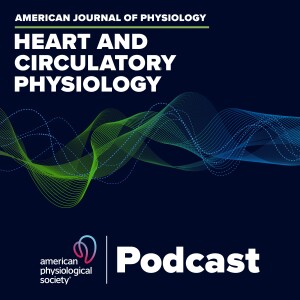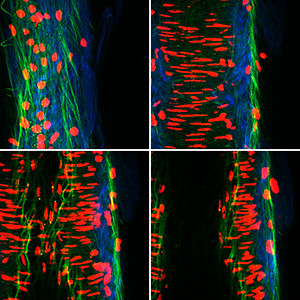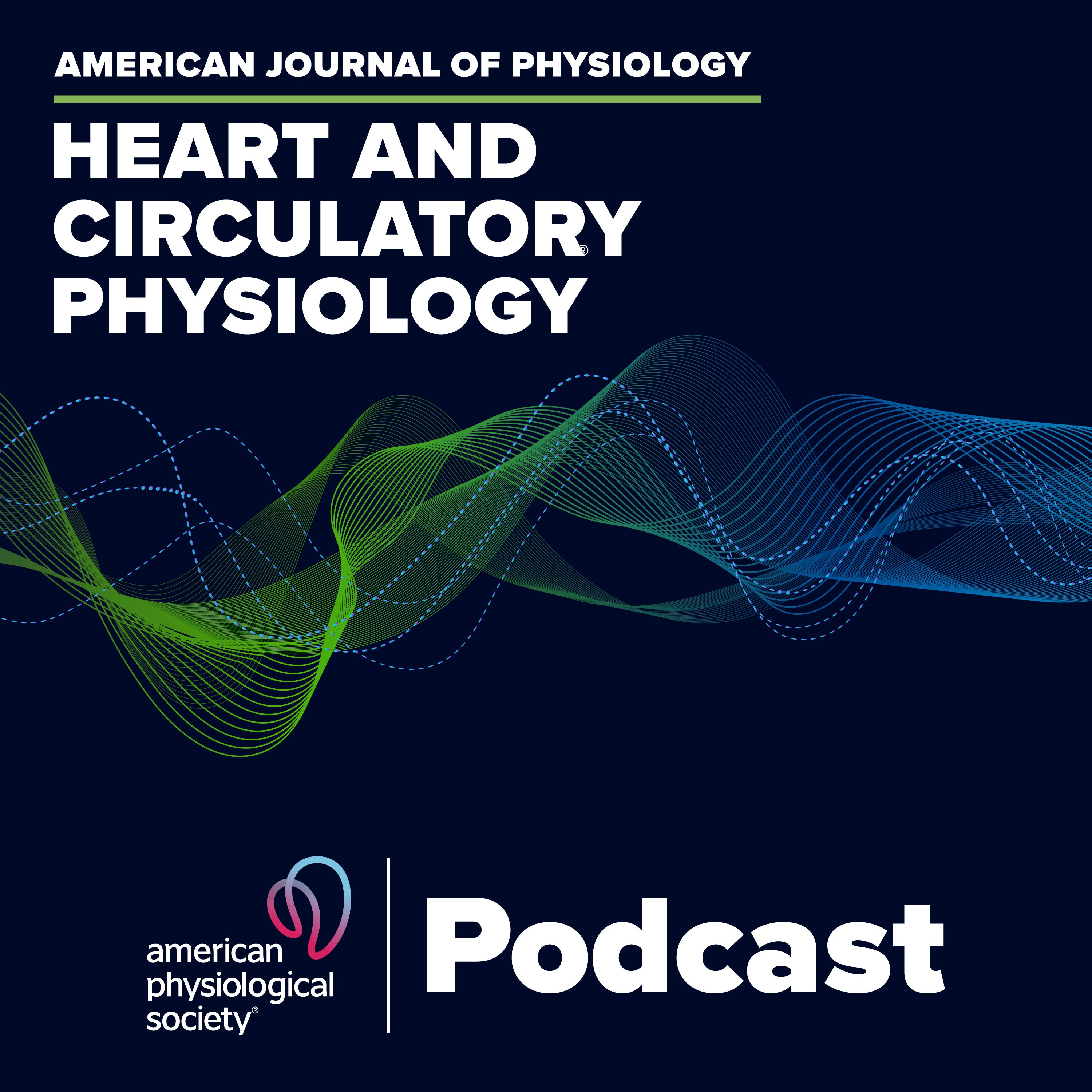Episodes

Thursday Jun 06, 2019
Dietary Sodium, Oxidative Stress and Microvascular Function
Thursday Jun 06, 2019
Thursday Jun 06, 2019
How does dietary sodium affect cardiovascular health beyond its influence on blood pressure? In this lively podcast, Associate Editor Nisha Charkoudian (U.S. Army Research Institute of Environmental Medicine) interviews lead author David G. Edwards (University of Delaware) and R. Matthew Brothers (University of Texas at Arlington) about the innovative study by Ramick et al examining the mechanisms by which high dietary sodium may impair vascular function. The authors used 24-hour blood pressure monitoring to identify blood pressure-independent effects of a high salt diet for salt-resistant individuals, compared to salt-sensitive individuals. Using a 7-day randomized high and low salt diet protocol, as well as intradermal microdialysis, the authors built on previous work to investigate specific mechanisms of oxidative stress in the microvasculature with a high-salt diet. Was the source of reactive oxygen species superoxide? From a public health perspective, does this study suggest that we need to shift focus from sodium and blood pressure, to sodium and overall cardiovascular health? Listen and find out.
Meghan G. Ramick, Michael S. Brian, Evan L. Matthews, Jordan C. Patik, Douglas R. Seals, Shannon L. Lennon, William B. Farquhar, and David G. Edwards Apocynin and Tempol Ameliorate Dietary Sodium-Induced Declines in Cutaneous Microvascular Function in Salt Resistant Humans Am J Physiol Heart Circ Physiol, published May 10, 2019. DOI: 10.1152/ajpheart.00786.2018

Friday May 03, 2019
Maternal Obesity Induces Transgenerational Cardiac Mitochondrial Dysfunction
Friday May 03, 2019
Friday May 03, 2019
Does maternal obesity have transgenerational effects on the cardiovascular health of offspring? Listen as Deputy Editor Merry Lindsey (University of Nebraska Medical Center) interviews authors Kelle Moley and Abhinav Diwan (both at Washington University in St. Louis), along with content expert Linda May (East Carolina University) about the unique study by Ferey and colleagues. In this elegantly designed study, the authors fed female C57 black mice a high fat-high sucrose diet for 9 weeks before mating with male mice on a normal diet. The female mice remained on the high fat-high sucrose diet for the duration of their pregnancies, and after birth, pups were weaned to a normal diet. Ferey et al showed that the offspring, despite not being obese, demonstrated cardiac mitochondrial abnormalities and reduced oxygen consumption. In addition, increased left ventricular mass persisted three generations. What are the potential public health implications of this work? Listen now.
Jeremie L. A. Ferey, Anna L. Boudoures, Michaela Reid, Andrea Drury, Suzanne Scheaffer, Zeel Modi, Attila Kovacs, Terri Pietka, Brian J. DeBosch, Michael D. Thompson, Abhinav Diwan, and Kelle H. Moley A maternal high-fat, high-sucrose diet induces transgenerational cardiac mitochondrial dysfunction independently of maternal mitochondrial inheritance Am J Physiol Heart Circ Physiol, published May 2, 2019. DOI: 10.1152/ajpheart.00013.2019

Monday Apr 29, 2019
Proteostasis in Senescent Endothelial Cells
Monday Apr 29, 2019
Monday Apr 29, 2019
Do senescent primary human coronary artery endothelial cells have a diminished heat shock response and/or impaired proteostasis? Listen as Editor in Chief Irving H. Zucker (University of Nebraska Medical Center) interviews lead author Aldrin Gomes (University of California Davis) and content expert Cameron McCarthy (University of Toledo) about this novel new study by Hwang et al, which determines that estrogen did not decrease protein aggregation nor improve the heat shock response in senescent vascular endothelial cells. As the current study was performed using all female donor coronary artery endothelial cells, the authors suspect sex differences play a key role in estrogen and heat shock response. How might the regulation of anti-oxidant enzymes and the pro- anti-oxidant transcription factor Nrf-2 play a role in reducing oxidative stress and proteolysis? Does a so-called Mediterranean diet show promise in reducing levels of oxidative stress biomarkers? Listen and learn more.
HyunTae V. Hwang, Yun Lin, Michelle N. Rebuffatti, Darlene T. Tran, Lily Lee, Aldrin V. Gomes, Chin-Shang Li, and Anne A. Knowlton Impaired proteostasis in senescent vascular endothelial cells: a perspective on estrogen and oxidative stress in the aging vasculature Am J Physiol Heart Circ Physiol, published February 1, 2019. DOI: 10.1152/ajpheart.00318.2018

Friday Apr 26, 2019
K+ Channel Isoforms Regulate Human Atrial Arrhythmogenesis
Friday Apr 26, 2019
Friday Apr 26, 2019
Can small changes in action potential duration have a major impact in human atrial electrophysiology? Listen as Associate Editor Mario Delmar (New York University) interviews authors Wayne Giles (University of Calgary) and Sanjiv Narayan (Stanford University) along with content expert Brian Delisle (University of Kentucky) about the new study by Ni et al. Combining mathematical modeling and clinical observations, Ni et al found that alternans could be strongly influenced by the types of potassium currents expressed in atrial myocytes, and that some potassium channel isoform switches occurring in atrial fibrillation may affect atrial physiology. The current study takes a reductionist approach to compare a single atrial control myocyte and a single myocyte in a-fib. What might the authors find if they replicate the isoform switch and study the conducted action potential in a 2-dimensional “sausage” of hundreds of myocytes? Listen and learn more.
Haibo Ni, Henggui Zhang, Eleonora Grandi, Sanjiv M. Narayan, and Wayne R. Giles Transient outward K+ current can strongly modulate action potential duration and initiate alternans in the human atrium Am J Physiol Heart Circ Physiol, published February 20, 2019. DOI: 10.1152/ajpheart.00251.2018

Tuesday Mar 26, 2019
Heterogeneous Sodium in Ventricular Myocytes
Tuesday Mar 26, 2019
Tuesday Mar 26, 2019
Is sodium evenly or unevenly distributed in the subsarcolemmal space? Intracellular sodium is an important regulator of cardiac contractility and plays a role in cardiac arrythmias. Therefore, understanding how and why sodium may be differentially distributed in the subsarcolemmal space is critically important. Associate Editor Mario Delmar (New York University) interviews lead author Jonas Skogestad (University of Oslo) and content expert Sand Despa (University of Kentucky) about the novel studies by Skogestad et al. Using both patch-clamping and mathematical modeling, Skogestad and co-authors challenge the current paradigm by suggesting that subsarcolemmal sodium may exist in not just one, but rather many, compartments. The authors found that, after activating the sodium channel for a short amount of time, the sodium released into the subsarcolemmal space did not affect Na+/K+-ATPase (NKA) activity. Did the same hold true for longer activation times, and what does this indicate about the possible interaction between the sodium pump and sodium channels? Listen now.
Jonas Skogestad, Glenn Terje Lines, William E. Louch, Ole M. Sejersted, Ivar Sjaastad, and Jan Magnus Aronsen Evidence for heterogeneous subsarcolemmal Na+ levels in rat ventricular myocytes Am J Physiol Heart Circ Physiol, published January 18, 2019. DOI: 10.1152/ajpheart.00637.2018

Friday Mar 22, 2019
Mitochondrial Oxidative Stress in Smoking and Hypertension
Friday Mar 22, 2019
Friday Mar 22, 2019
Tobacco smoking is still a major global public health risk, despite the well-known facts that smoking increases the risk of cardiovascular disease and hypertension. What is the mechanism by which tobacco smoking induces mitochondrial oxidative stress? Editor-in-Chief Irving H. Zucker (University of Nebraska Medical Center) interviews lead author Sergey Dikalov (Vanderbilt University Medical Center) and content expert Andreas Beyer (Medical College of Wisconsin) about the new study by Dikalov et al that uses a unique chronic tobacco smoking model in both human and animal tissues to determine that smoking induces oxidation of mitochondrial cardiolipins. Dikalov and co-authors performed novel catalase experiments to show that smoking interferes with cell signaling pathways, and that specific scavenging of mitochondrial catalase can prevent alterations of vascular functions. Short-term (just 2 weeks!) of tobacco smoking showed marked reductions in SIRT3, which is a key mitochondrial deacetylase and a marker of longevity. Did smoking cessation return SIRT3 to normal healthy levels? Listen and learn.
Sergey Dikalov, Hana Itani, Bradley Richmond, Aurelia Vergeade, S. M. Jamshedur Rahman, Olivier Boutaud, Timothy Blackwell, Pierre P. Massion, David G. Harrison, and Anna Dikalova Tobacco smoking induces cardiovascular mitochondrial oxidative stress, promotes endothelial dysfunction, and enhances hypertension Am J Physiol Heart Circ Physiol, published February 27, 2019. DOI: 10.1152/ajpheart.00595.2018

Wednesday Mar 06, 2019
Vasoconstriction in White and Brown Adipose
Wednesday Mar 06, 2019
Wednesday Mar 06, 2019
How is adipose tissue vascular reactivity impacted by obesity? Editor in Chief Irving H. Zucker (University of Nebraska Medical Center) interviews lead author Lisa Lesniewski (University of Utah) and content expert Camilla Wenceslau (University of Toledo) about this central question in the new study by Hazra et al. To explore the differential activity of feed arteries from both white and brown adipose tissue to important vasoconstrictors, Lesniewski and co-authors used a pressure myography system to examine vasoreactivity in excised feed arteries from normal and high-fat diet fed mice. Despite greater non-receptor mediated vasoconstriction in arteries from brown adipose tissue, the authors did not find an increase in receptor mediated vasoconstriction in brown adipose tissue compared to white adipose tissue. In general, Lesniewski and colleagues found that a high-fat diet lowered reactivity to the receptor-mediated agonists. Could stimulating blood flow in the vasculature of brown adipose tissue have clinical implications for fighting the obesity epidemic? Listen and learn more.
Sugata Hazra, Grant D. Henson, R. Colton Bramwell, Anthony J. Donato, and Lisa A. Lesniewski Impact of high-fat diet on vasoconstrictor reactivity of white and brown adipose tissue resistance arteries Am J Physiol Heart Circ Physiol, published February 12, 2019. DOI: 10.1152/ajpheart.00278.2018

Tuesday Mar 05, 2019
HIF1 Regulates miR-29c and SERCA2
Tuesday Mar 05, 2019
Tuesday Mar 05, 2019
How does HIF1 regulate microRNAs in the heart? This is the question we explore in our latest podcast. Listen as Associate Editor Junichi Sadoshima (Rutgers New Jersey Medical School) interviews authors Ralph Shohet and Allison Williams (both of University of Hawaii), along with content expert Asa Gustafsson (University of California-San Diego), about the intriguing new work by Williams et al. It is known that miR-29c is a critical mediator of HIF1 for downregulation of SERCA2, which is commonly seen in heart failure. Using a tetracycline-inducible transgenic mouse model with an oxygen-stable form of HIF, the authors observed deeper levels of HIF action in the heart. What consequences of stable HIF1 activation did the authors uncover? How closely does isolated HIF expression mimic authentic ischemia? Listen and find out.
Allison Lesher Williams, Chad B. Walton, Abigail Avelar, and Ralph Victor Shohet HIF-1 regulation of miR-29c impairs SERCA2 expression and cardiac contractility Am J Physiol Heart Circ Physiol, published February 20, 2019. DOI: 10.1152/ajpheart.00617.2018

Wednesday Jan 23, 2019
MRGD Deficiency Leads to Dilated Cardiomyopathy
Wednesday Jan 23, 2019
Wednesday Jan 23, 2019
What are the cardiac effects of genetic deletion of the alamandine peptide receptor MRGD? Listen as Associate Editor Debra Diz (Wake Forest University School of Medicine) interviews lead author Robson Santos (Universidade Federal De Minas Gerais, Brazil) and content expert Michelle Parvatiyar (Florida State University) about the innovative work by Oliveira et al. Santos and co-authors found that genetic deletion of MRGD in mice triggered the development of severe dilated cardiomyopathy in the absence of hypertension. Robson and colleagues found several key phenotypic changes—increased adiposity chief among them—but no changes in blood pressure in the MRGD knockout mice. Surprisingly the authors found a decrease in ANP expression, leading them to consider ANP key to the pathogenesis of the cardiac dysfunction in this animal model. Don’t miss the behind-the-scenes story of how alamandine got its unique name. Listen now.
Aline Cristina Oliveira, Marcos Barrouin Melo, Daisy Motta-Santos, A Augusto Peluso, Fernando Souza-Neto, Rafaela F da Silva, Jonathas FQ Almeida, Giovanni Canta, Adelina M. Reis, Gleisy Goncalves, Gabriela G Cerri, Danielle Coutinho, Itamar Couto Guedes de Jesus, Silvia Guatimosim, Natalia D Linhares, Natalia Alenina, Michael Bader, Maria José Campagnole-Santos, and Robson A. Souza Santos Genetic deletion of the alamandine receptor MRGD leads to dilated cardiomyopathy in mice Am J Physiol Heart Circ Physiol, published January 8, 2019. DOI: 10.1152/ajpheart.00075.2018

Tuesday Jan 08, 2019
Differential Control of Sympathetic Outflow in Young Humans
Tuesday Jan 08, 2019
Tuesday Jan 08, 2019
What drives variability in muscle sympathetic nerve activity among healthy individuals? Associate Editor Nisha Charkoudian (U.S. Army Research Institute of Environmental Medicine) explores this central question in a new interview with lead author Philip Millar (University of Guelph) and content expert Craig Steinback (University of Alberta) about the work by Incognito et al. Millar and co-authors identified subpopulations within muscle sympathetic single unit nerve fibers that display opposite responses to typical sympathoexcitatory stressors-- lower body negative pressure and an exercise stimulus. The authors uncovered that we can recruit, and de-recruit, individual muscle sympathetic nerve fibers in response to these stressors. What are the potential clinical implications for patients with orthostatic intolerance or hypertension? Listen to find out.
Anthony V. Incognito, Connor J. Doherty, Massimo Nardone, Jordan B. Lee, Karambir Notay, Jeremy D. Seed, and Philip J. Millar Evidence for differential control of muscle sympathetic single units during mild sympathoexcitation in young, healthy humans Am J Physiol Heart Circ Physiol, published December 17, 2018. DOI: 10.1152/ajpheart.00675.2018

